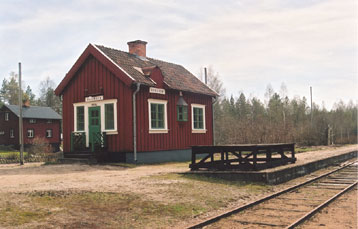
The modest stationbuilding in Göringen as seen today.
In the Background, the former living quarters for the staff. The house serves today as a holiday cottage.
Colorphotos by Ollie Ahokas,
black and whites from the book Göringnen - Dalfors by Föreningen Dala-Hälsinglands Järnväg
What is available.
The last few years has been a boom for Scandinavian models, Untill late eighties there was nothing but 4 firms that produced a RC-class electric and one making Da-electric. Of coarse there was a model of Sb/S2-class 2-6-4 tank produced by Tenshodo, which became a priceless collectors item. But in late eighties things started to change.First a plastic and very basicly modelled railcar of Y6/Y7 came into market with a large variation of matching trailers. The early versions ran poorly, and the later versions got a powertruck from Bachmanns GE-44 tonners, with a slightly improved performance. Lima started to produce a very basic T43 in both earlier SJ-schemes. Both the railbus and the diesel fits right in on this line.

DHJ/Jecos model of the E-class steamer. all images of models by Jeco AB
The first of the steamengine kits from DHJ/Jeco AB came to the market. The first kit that was available as ready to run version was the 0-8-0 of E-class. The engine was orginally built to haul trains of the famous Inland line from south to north. A number of these were rebuilt in to 2-8-0.s and the second kit was this version. I have a model of these engines and they look and perform pretty nicely. The Swedish firm UGJ also offered the 2-axle Y-class railcar used on the line.

DHJ/Jecos model of the E2-class steamer. all images of models by Jeco AB One of the engines from DHJ/Jeco that fits right in is their model of E10, orginally these 4-8-0.s was produced in 1947 for Inland line in mind. Brimalm and others has produced models of the impressive 4-6-0 class B. These models were expensive, Brimalms version was based on the orginal SJ design and looked like a beauty. There has been some rumours that they run perfect on straight track but derails on curves and turnouts.... The other has been rather unsuccesful kitbashes basing on drivelines and chassis on available chassies. I haven´t seen any of the E10.s or the various B-classes run except on a testbed straight track. But the E10-looks right and impressive with their smoke deflectors. A number of typical freight cars from steam and early dieselera are offered by UGJ. Roco offers a ex. private line G-class boxcar and a tankcar.

DHJ/Jecos model of the E10-class steamer. all images of models by Jeco AB
If you like to model the line today, you can use Limas T43 in the green TGOJ paint scheme, if you canfind one as this version was a limited edition. The model reflects the engine as it was during the earlier days, with a skirt over the frame and no handrail on front platform. As the model still uses their old motor, they had to add unprototypical bulges on the short hood. There are number of small swedish firms who offers new chassis to this engine. In 2001, kits of the matching log cars are offered by Tågspecialisten, a typical train consists of the T43 and about a dousin of these cars. Sometimes if the venerable is in service or trouble, a IBAB TMX fills in. Model of these are offered by Heljan.
On buildings you are on your own, but the buildings are rather few and of rather simple designs, so your scratchbuilding project would be straight forward. Of cause you can use Helajns kit of Swedish farm for the few residentals in Göringen.